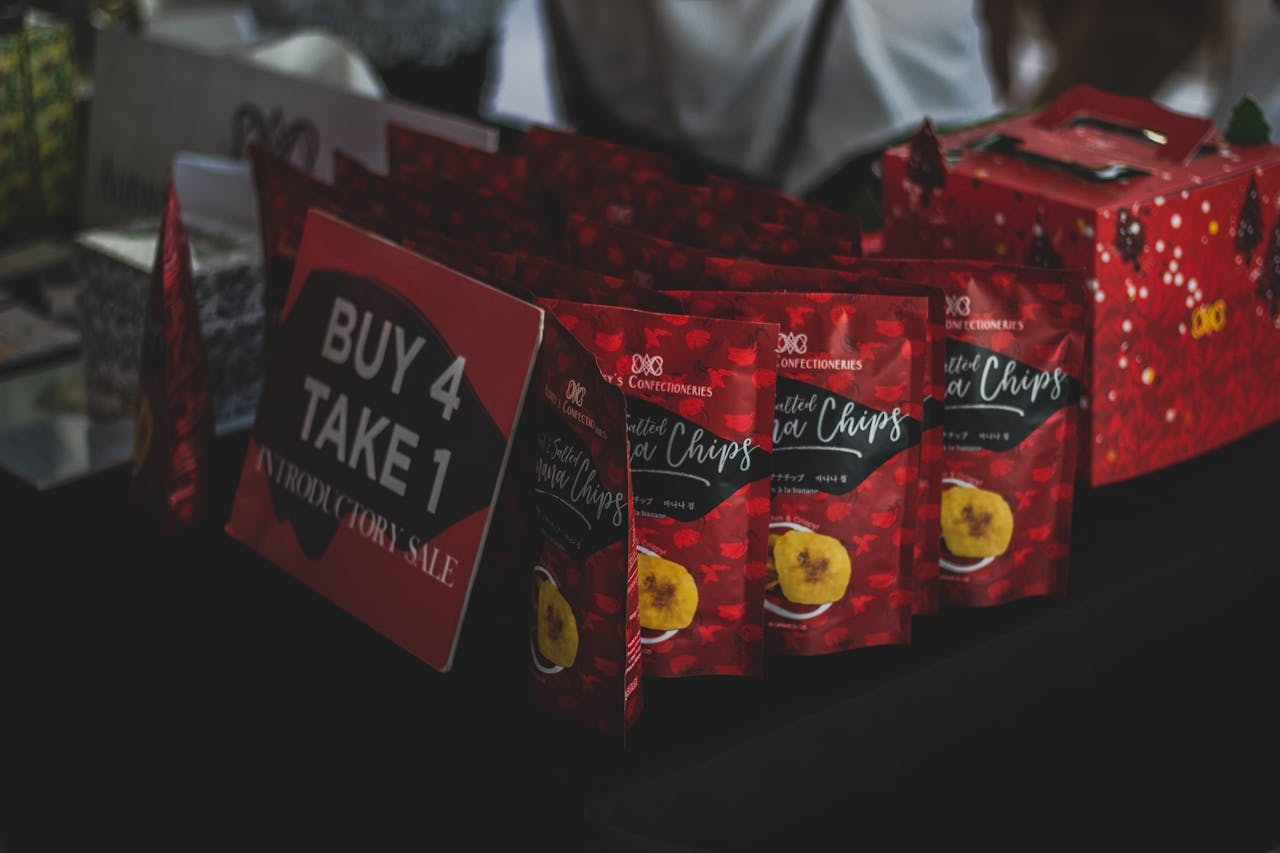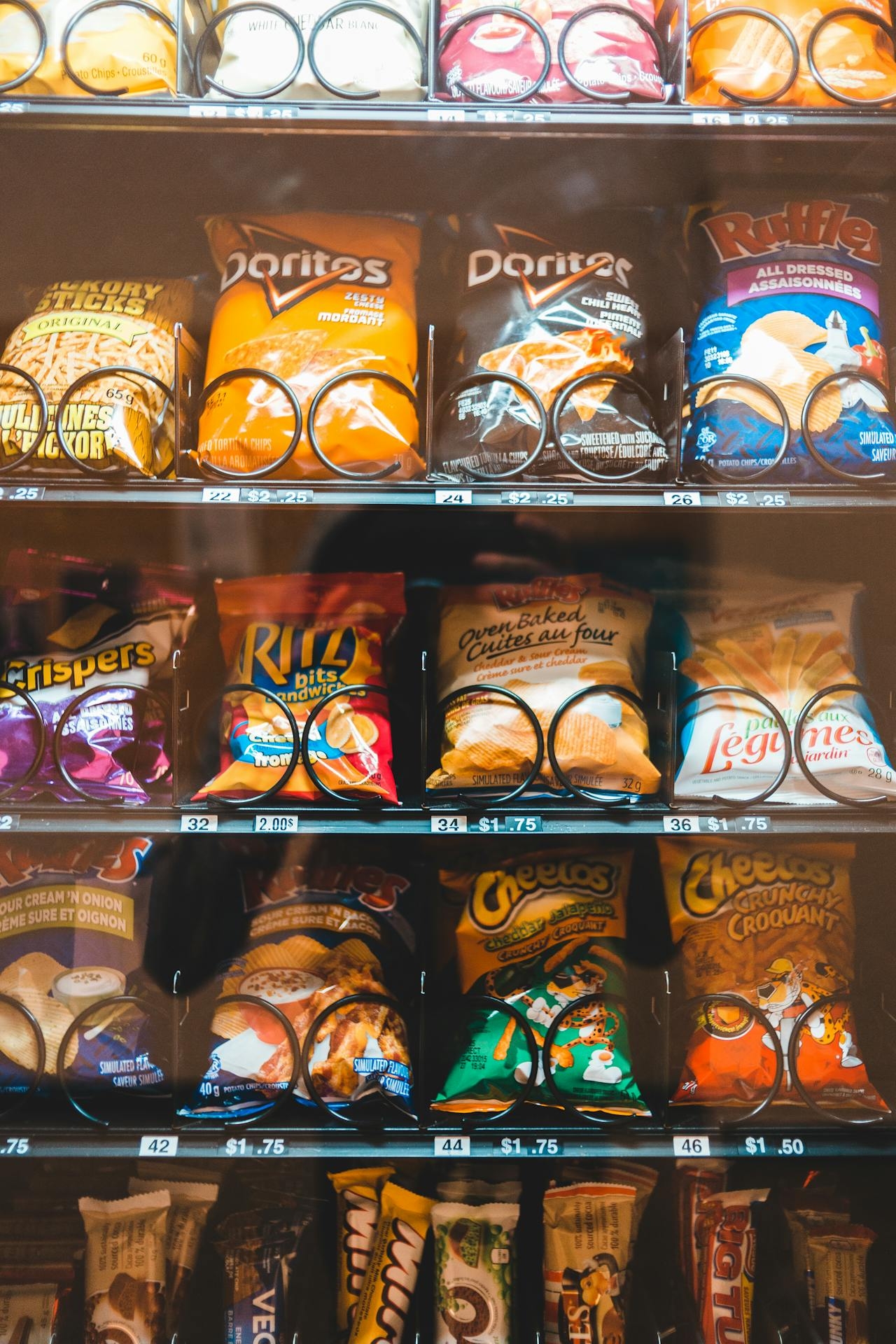Unwrapping the Impact: How Packaging Influences Buying Decisions
By Anttoni Taimela · 2. April 2024
Choosing a product often comes down to its packaging. But why?
This article answers that pivotal question, zeroing in on how packaging influences buying decisions.
We’ll reveal the role of design, materials, and functionality in shaping your preferences—no fluff, just the compelling facts about the silent salesmanship of packaging.
The Visual Appeal of Packaging Design
 branded food packaging
branded food packaging
It’s a bustling, competitive, crowded marketplace out there, and brands need to stand out. Enter the visual appeal of packaging design.
A well-designed package can trigger curiosity and communicate product quality, serving as a bridge to engage the consumer’s interest.
Picture yourself walking down a supermarket aisle.
Amid the sea of products, a unique package piques your interest, and you find yourself reaching out to take a closer look.
That’s the power of effective packaging design – it captures consumer attention and effectively conveys the brand’s values.
Just as a diamond shines amongst pebbles, distinctive packaging draws in more consumers by standing out from the competition.
The presentation of the product now holds as much importance as the product itself.
Unconventional designs generate consumer intrigue and engagement, subsequently influencing purchasing decisions.
Packaging design becomes a deciding factor in sales success when consumers are flooded with choices.
The Power of Color in Packaging
Color – it’s not just a visual treat, it’s a psychological powerhouse.
Color psychology plays a significant role in packaging, evoking different emotions and associations, which are essential in shaping consumer perceptions.
Some examples of color associations in packaging include:
- Red: Encourages impulse buying
- Blue: Triggers a more reflective purchase response
- Orange: Attention-grabbing and promotes positivity
- Black: Exudes sophistication
Brands strategically employ color combinations to relay attributes such specific emotions such as trust and security, which are essential in communicating their brand values.
For instance, white denotes purity and simplicity, green symbolizes freshness and eco-friendliness, and purple represents luxury and sophistication.
Color in packaging wields power by influencing a spectrum of consumer emotions from happiness to optimism and energy, while signifying attributes like freshness and quality, thus considerably affecting purchasing decisions.
Typography and Imagery as Brand Messengers
 corporate food packaging design
corporate food packaging design
Beyond color, typography and imagery also play vital roles in conveying a product’s identity and differentiating the brand.
Typography in packaging design can define the product and helps to convey information and differentiate the brand, with consumers forming impressions of the message conveyed by typeface choices even before reading the text.
Different styles of font suggest attributes such as tradition, modernity, or luxury to the consumer.
Technological advancements in digital printing have made it possible to highly customize packaging typography, thereby granting the freedom to present personalized messages and alternative designs that foster a brand’s story development and versatility.
Typography design in packaging takes into account several factors such as:
- Visibility-related packaging shape and size
- Balance and symmetry for visual appeal
- Appropriate use of uppercase and lowercase letters for effortless information intake.
The Unboxing Experience
Unboxing a product is no less than a ceremony for many consumers. This experience can significantly impact their perception of the brand.
Apple’s minimalist packaging, for example, is carefully crafted to create a sensory experience that underscores the company’s core philosophies, fostering brand loyalty.
In e-commerce, the packaging is a significant component that shapes the impact of packaging customer’s initial interaction with the product, enhancing overall satisfaction with the brand.
An exceptional unboxing experience can fuel online brand visibility, courtesy of social sharing by consumers and influencers alike.
Incorporating unexpected extras like personalized messages, free samples, or special offers within the packaging can elevate the unboxing experience, leaving a memorable and lasting impression on consumers.
The Role of Material and Finish in Perceived Quality
 Biodegradable Packaging
Biodegradable Packaging
The choice of material and finish, alongside the visual appeal of packaging, has considerable influence on consumers’ perception of product quality.
High-quality packaging materials reflect positively on the product inside and the brand as a whole, influencing consumer brand trust, and brand loyalty.
Conversely, if the packaging material appears delicate or susceptible to damage, it may discourage a customer from choosing the brand.
Durable packaging significantly influences consumer satisfaction with the product and shapes brand relationships.
Eco-Friendly Materials: A Reflection of Brand Ethics
Eco-friendly🌍🌱 packaging has emerged as a game-changer in the age of mindful consumerism.
It not only reflects positively on the product quality but also showcases a brand’s commitment to sustainability.
There is a growing consumer demand for sustainable packaging solutions that:
- Reduce single-use plastic
- Are biodegradable or compostable
- Use recycled materials
- Are lightweight and minimize carbon emissions during transportation
These packaging solutions not only help protect the environment but also contribute to a positive brand image and customer loyalty well known brand.
Companies that openly share their values and sustainability efforts on their packaging can gain more trust from consumers who prefer purchasing from businesses that contribute to the betterment of the planet.
For instance, ‘Boxed Water Is Better’ uses cardboard boxes made with 92% renewable materials, supporting their commitment to environmental conservation and decreasing carbon footprint in transportation.
Tactile Sensations and Durability
The tactile sensation of packaging, which consumers often prefer to touch before purchasing, can sway consumers minds and their perception of the product.
Packaging that provides positive tactile feedback can enhance the consumer’s perception of the product’s quality and enrich the overall sensory experience.
The weight and hardness of packaging can affect a consumer’s evaluation of the product, similar products with heavier packaging often perceived as more premium.
Moreover, the thickness and durability of packaging material, such as that of water bottles, can shape customer perceptions of a brand’s reliability and value.
Functionality and Convenience: More Than Just Looks
 Paper Packaging Design
Paper Packaging Design
The functionality and convenience of packaging share equal importance with its aesthetic appeal.
Features like protective seals and locks not only safeguard the product but also enhance the consumer’s trust in the product’s reliability.
The ease of use and the reusability♻️ of packaging materials significantly enhance the brand’s value in the eyes of consumers, reflecting its utility.
In food packaging, individual wrappers are preferred as they ensure hygiene by protecting items like chocolate candies from contamination.
Packaging has a myriad of roles, including:
- containing the product
- protecting it during transport
- offering convenience for consumers
- communicating essential information.
Innovative Features That Add Value
Features of innovative packaging can remarkably enhance the product’s value.
For example, active packaging systems that remove or control O2, ethylene, or moisture contribute to longer shelf life and sustained food quality.
Smart packaging with time-temperature indicators offers a visual cue of food quality by changing color or shape in response to temperature, allowing consumers to gauge the freshness of the product.
Innovative nanohydrogel materials in packaging can:
- React to temperature and pH changes
- Protect food integrity under varying environmental conditions
- Improve product shelf life and quality
- Provide a competitive edge in the market.
Brand Identity Embodied in Packaging
Packaging serves not only as a protective shell but also as a visual embodiment of the brand’s identity.
Branded packaging, with a brand logo serving as a visual trademark, should be easily recognizable and suggestive of the company’s quality and credibility.
Consistent use of colors, graphics, typography, and logo variations in packaging is a critical factor for maintaining a cohesive brand identity.
Essentially, the packaging should reflect the customer’s values, habits, and lifestyle to effectively target the right audience.
Consistency Across Product Lines
It’s vital to uphold consistency across varied product lines to strengthen the brand image and aid consumer recognition.
Coca-Cola, for example, has achieved packaging consistency across its product lines while allowing for variation.
Variations of Coca-Cola’s primary logo and color palette are effectively utilized to remind customers to differentiate between products within the same line.
Such consistency across product lines not only strengthens brand image but also aids in consumer recognition, reinforcing brand loyalty.
Psychological Triggers Activated by Packaging
 branded food packs
branded food packs
Beyond being an art form, packaging design functions as a psychological tool with the capacity to greatly sway consumer behavior.
Emotional engagement is paramount in packaging design as consumers’ brand-related decisions are largely based on emotion rather than logical reasoning.
Intelligent packaging design, which responds to environmental changes and can influence the perceived flavor or quality of food products, plays a vital role in capturing consumer attention and conveying product authenticity.
In essence, packaging caught the attention of consumers by incorporating key behavioral triggers and visual elements that align with the subconscious decision-making involved in most purchases.
Creating a Connection with Target Audience
Creating a connection with the target audience via packaging design can cultivate emotional bonds and nurture brand loyalty.
Defining the target audience, including factors like:
- job
- location
- income level
- marital status
Understanding your target audience plays a crucial role in creating packaging that resonates with them and helps to attract consumers, as well as attract customers.
Understanding customer values and habits, such as whether they are socially conscious or prefer luxury goods, is a determinant in informing packaging design choices.
By analyzing consumer behaviour, embedding different emotional triggers within the packaging design can relate the product to the consumer’s personal desires, creating a relevant emotional space.
The Silent Salesman: How Packaging Communicates
Packaging is frequently dubbed the ‘silent salesman’.
It showcases product contents, highlights key benefits, and aids consumers in making informed decisions.
Clear packaging materials allow consumers to directly see the product, enhancing transparency and influencing purchasing decisions.
Innovative companies like Help Remedies communicate effectively by simplifying complex information, making it accessible and less intimidating for consumers.
Devices like CO2 sensors in packaging provide insights into product freshness and integrity, reinforcing consumer trust.
Clarity and Honesty: Winning Consumer Trust
Ensuring transparency in product labels is pivotal for gaining consumer trust.
Clear labeling of ingredients and packaging materials that allow the product to be seen fosters consumer trust by meeting their expectations to know more about what they consume.
Brands must be authentic about their recyclable packaging, as misleading claims can create distrust and undermine a company’s transparency in environmental efforts.
Consumers also expect easily accessible contact information and excellent customer service, which are critical components in establishing and maintaining trust between them and a company.
The Competitive Edge: Standing Out in the Market
Unique and innovative packaging designs can help products differentiate themselves in a competitive market, thereby boosting consumer attention and perception of different brands.
As the market evolves, packaging designs need to be flexible and able to adjust to new trends, changes in consumer preferences, and competitors’ strategies in order to maintain a competitive advantage.
Customizing packaging designs for different demographics, regional markets, or seasonal promotions can increase the appeal of their products and boost sales.
Retail packaging serves as key advertising space, where branding and product benefits are communicated directly to customers in a physical placement that can sway purchase decisions.
Summary
In conclusion, packaging is far more than just a protective layer for a product; it’s a silent salesman, a visual storyteller, and a psychological trigger.
It not only plays a crucial role in attracting consumers but also in conveying brand values, fostering brand loyalty, and influencing purchasing decisions.
Whether it’s through color psychology, tactile sensations, or innovative features, packaging has the power to influence consumers emotions and make or break a sale.
So, the next time you’re shopping, take a moment to appreciate the art and science behind the packaging that caught your eye.
Frequently Asked Questions
How does packaging affect buying decisions?
Packaging design plays a significant role in shaping a consumer’s mind and perception and can influence buying decisions, even for those not planning to make a purchase. It communicates essential information about the product’s value and benefits. So, when you’re buying, remember that the packaging speaks volumes about what’s inside!
What are the factors influencing packaging decisions?
The factors that should influence your packaging decisions include cost, durability, eco-friendliness, and visual appeal. Choose materials that align with these criteria to make informed packaging decisions.
How does the product influence your buying decision?
The familiarity with the product and personal factors play a significant role in influencing your buying decision. The characteristics, price, availability, and personal lifestyle all contribute to the purchase decision-making process.
How does food packaging affect customers?
Food packaging can play a significant role in influencing customers’ purchasing decisions. It’s often said that the appeal of the packaging can sometimes outweigh the actual product – just think of those alluring colors and enticing images used by food companies.
Why is packaging important in marketing?
Packaging is crucial in marketing your business because it silently sells the product, highlights its benefits, and helps customers make informed decisions. It also works as valuable advertising space to communicate branding and product benefits directly to consumers. So, it’s like having a salesperson working 24/7 for your product!

